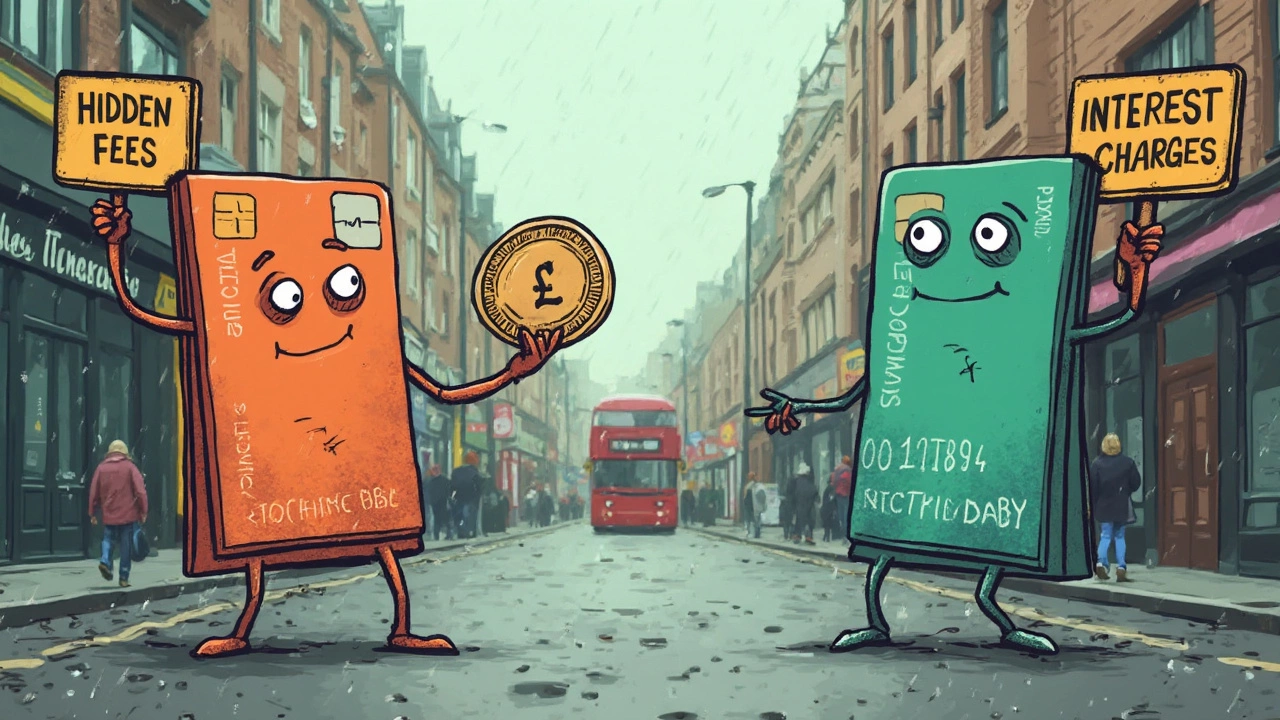If you’ve ever felt stuck with credit card debt, you might wonder if you can just use another credit card to pay it off. Sounds simple, right? Not quite. Swiping one card to pay another usually doesn’t work—most credit card companies won’t let you pay a bill directly with a different card.
But there’s a workaround called a balance transfer. That’s when you move what you owe on one credit card over to another card, usually one with a lower interest rate. Big banks love to throw out offers like “0% APR for 18 months” to reel you in. So technically, it’s possible—but there are some catches. Not all cards let you transfer balances, and there’s almost always a fee, usually 3% to 5% of what you transfer.
- How Credit Card Payments Actually Work
- Balance Transfers: The Real Deal
- Things No One Tells You About Hidden Costs
- Tips for a Smooth Debt Shuffle
- When Paying Off Credit With Another Card Makes Sense
How Credit Card Payments Actually Work
Here’s the real deal: credit card payments are almost never about moving money from one credit card to another. When you get your statement, your options to pay are usually:
- Electronic payment from a checking/savings account
- Phone payment using a bank account number
- Mailing a check or using your bank’s online bill pay service
Just plugging in another credit card number on your payment screen won’t work, no matter which bank you use. This is because credit card companies process payments through regular bank accounts, not plasticky card-to-card swaps.
More than 80% of U.S. consumers actually pay their cards with online banking or mobile apps, according to recent Federal Reserve numbers. Credit card companies only accept cash, checks, or funds from real bank accounts when you make a payment.
| Payment Method | Accepted for Credit Card Bill? |
|---|---|
| Checking/Savings Account | Yes |
| Debit Card (some issuers) | Sometimes |
| Another Credit Card | No |
| Cash (in branch) | Yes |
So, paying off one credit card with another directly isn’t a real option. But there are workarounds, like balance transfers, and some sneaky methods people try—like taking a cash advance (which usually comes with steep fees and higher interest).
If you really want to juggle credit card balances, you’ll need to look beyond standard payment setups. Understanding these basics lays the groundwork for smarter debt moves—like knowing when a balance transfer might actually help you dodge extra interest.
Balance Transfers: The Real Deal
A balance transfer is basically moving the amount you owe from one credit card to another, usually chasing a lower interest rate. You aren’t just dodging your old card’s payment; you’re moving the debt, often to buy time and save money on interest. Most people jump on these offers to stop wasting cash on insane interest rates—some cards will charge you up to 28% if you leave a balance alone.
But here’s how it really works. When you sign up for a balance transfer card, you usually get a short “intro” period where you pay low or zero interest—think 0% APR for 12 to 21 months. That’s your window to make a dent in that debt without more interest piling up.
- There’s nearly always a balance transfer fee. Usually 3% to 5% of whatever you move over. So, if you transfer $5,000, the fee might hit $150 to $250 right away.
- You can’t transfer between cards from the same bank. For example, moving debt from one Chase card to another Chase card? Not gonna happen.
- Your credit limit on the new card matters. If your limit is $4,000 and your debt is $6,000, you can’t transfer the whole amount.
- Pay attention to the regular APR. Once the intro period ends, the rate could shoot up as high as 25% or more.
Here’s a snapshot of what balance transfer deals usually look like:
| Card Name | Intro APR | Intro Length | Transfer Fee |
|---|---|---|---|
| Chase Slate Edge | 0% | 18 months | 3% (min $5) |
| Citi Simplicity | 0% | 21 months | 5% (min $5) |
| Discover it Balance Transfer | 0% | 18 months | 3% |
So, with a little planning, a balance transfer can help you actually knock down your debt. But it’s not a magic fix—you have to do the math, read the terms, and make sure you’re not just trading one problem for another. And remember, credit card payments only get easier if you stop adding new charges while paying down your transferred balance.

Things No One Tells You About Hidden Costs
A balance transfer seems like a fast way out of debt, but sneaky little costs can pop up and wreck your money-saving plans. The biggest surprise? That tempting intro rate doesn’t last forever, and if you’re not careful, you could get slapped with extra charges that cancel out any savings.
First, let’s talk fees. Most cards charge a balance transfer fee between 3% and 5% of the amount you move. So, if you bring over a $5,000 balance and your fee is 5%, that’s an extra $250 right off the top. You don’t hand over $5,000—you pay $5,250.
| Hidden Cost | Typical Amount | When It Hits |
|---|---|---|
| Balance Transfer Fee | 3-5% of transfer | Immediately |
| Late Payment Fee | Up to $35 | If you miss a payment |
| Purchase APR | 17% or higher | On new purchases (not the balance transfer) |
| Go-To APR | 16-28% | After 0% intro ends |
Another catch: the 0% promotional rate usually only applies to balances you transfer—not to any new purchases you make with that card. If you start swiping for groceries or gas, you’ll likely pay the normal purchase APR (which is easy to miss in the fine print and averages over 20% in the U.S. right now).
Mess up a payment, and you can lose your promo rate. Miss the due date just once, and your interest rate could shoot up, making your entire plan fall apart. Plus, if you don’t pay off the transfer before the promotion ends, the rest of your balance starts racking up interest at the regular rate—sometimes 25% or higher.
Don’t forget about the impact on your credit card payments. Moving debt around bumps up the amount of available credit you’re using, which can ding your credit score if you max out a new card. And if you close the old card, your available credit shrinks, which can also hurt your score.
The takeaway? Always read the terms for fees, watch out for high regular APRs, and plan your payments so you pay off the balance before losing that low intro rate.
Tips for a Smooth Debt Shuffle
Doing a balance transfer can save you real money—if you play your cards right. Here's what makes a difference when trying to pay off one card with another without getting tripped up by sneaky charges or credit score surprises.
- Compare credit card payments offers before you move a single dollar. Check the intro APR, how long it lasts, and the balance transfer fee. Don’t just grab the first 0% offer you see—some only give you six months, while others stretch to 21 months.
- Read the fine print for “balance transfer fees.” Most banks charge between 3% and 5% for every dollar you move. If you transfer $5,000, you're looking at up to $250 in fees right off the bat.
- Act fast after getting the card. Some cards give you just 60 days to transfer your balance and get that sweet promo rate. Wait too long and you’re stuck with their regular (much higher) APR.
- Make sure your new credit limit can handle the transfer. If the new card’s limit is less than what you owe, you won’t be able to move everything and that defeats the point.
- Keep paying your old card’s bill until you see a $0 balance. Transfers can take a week or even longer to process, and one late payment might nuke your credit score.
| Card | Intro APR | Duration | Transfer Fee |
|---|---|---|---|
| Chase Slate Edge | 0% | 18 months | 3% |
| Wells Fargo Reflect | 0% | 21 months | 5% |
| Citi Double Cash | 0% | 18 months | 3% (then 5%) |
Don’t rack up new debt on your old card after making a transfer. That’s one of the top mistakes people make—you just end up in deeper water. And try not to close your paid-off card immediately. Old accounts help your credit score, and closing them can make it drop a few points.
If you want to avoid interest entirely, set up automatic payments to wipe out the debt before that intro period ends. When the promo rate ends, APRs jump big time—sometimes 18% or higher. Nobody needs that kind of surprise.

When Paying Off Credit With Another Card Makes Sense
There really are some situations where using another card to wipe out your existing balance isn’t just possible—it’s smart. The most common way is through a balance transfer, and sometimes it can save you serious cash. For example, if you’re getting hit with 28% interest every month and you get a 0% intro offer for 12 to 18 months on a new card, you could avoid handing over piles of money just to cover interest.
Here are specific moments it’s actually a good move:
- You qualify for a credit card payments offer with 0% interest or a much lower rate than your current card.
- You know you can pay off the balance before the intro period runs out.
- Your credit score is high enough to get those good offers—most 0% balance cards want a score of at least 680.
- The transfer fee doesn’t eat up your savings (do the math; sometimes that 3% or 5% fee adds up fast).
- You don’t plan to use your new card to rack up new purchases while you’re still paying off the balance.
Take a look at how the savings can add up if you play your cards right:
| Situation | Interest Rate | Monthly Payment | Total Interest Paid (12 Months) |
|---|---|---|---|
| Existing Card | 28% | $250 | $700 |
| Balance Transfer | 0% (with 3% fee) | $250 | $75 (transfer fee only) |
So in this example, you’d save more than $600 in interest over a year, just by making the switch and paying the same monthly amount. Not bad, right?
But there’s a trick to this: only do it if you’re confident you can pay off the new balance before the 0% period ends, or you could end up with an even higher rate once the intro deal expires. People sometimes forget, and suddenly the new card’s APR spikes to 25% or more. Mark your calendar with the intro end date so you don’t lose track.
And if your credit isn’t great and you only qualify for cards with similar or higher rates, transferring balances just shuffles debt around without really fixing things. As always, check all the fine print—especially the transfer fee and the regular APR after the intro window.
